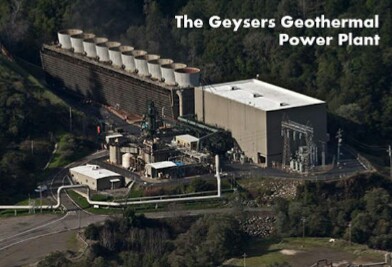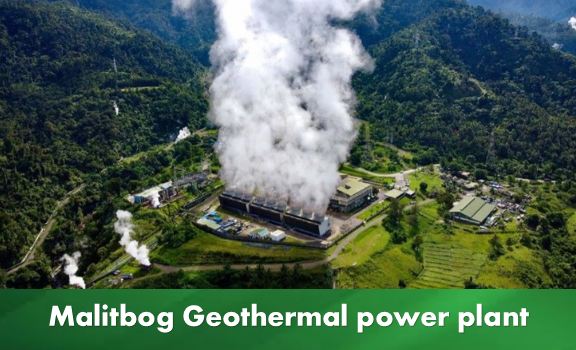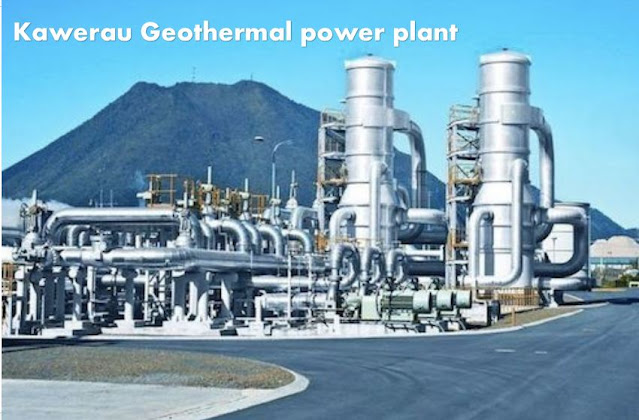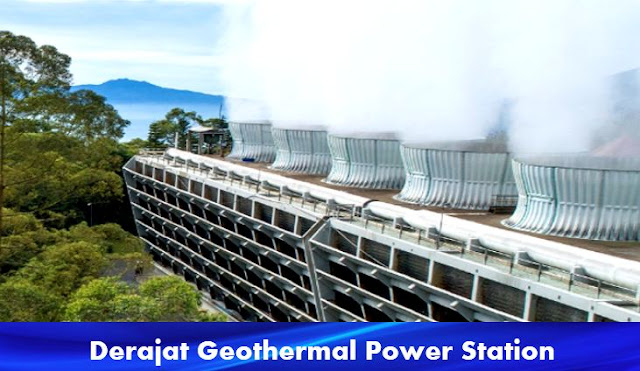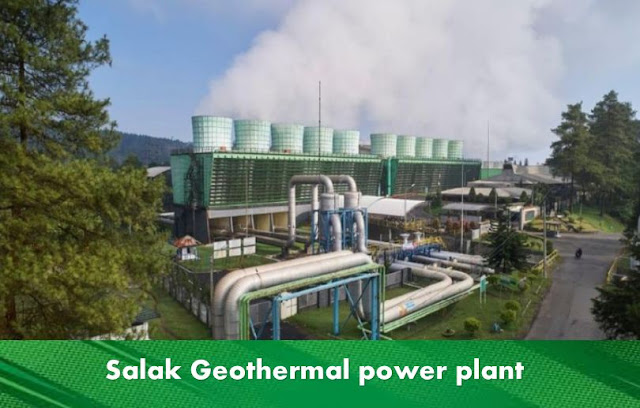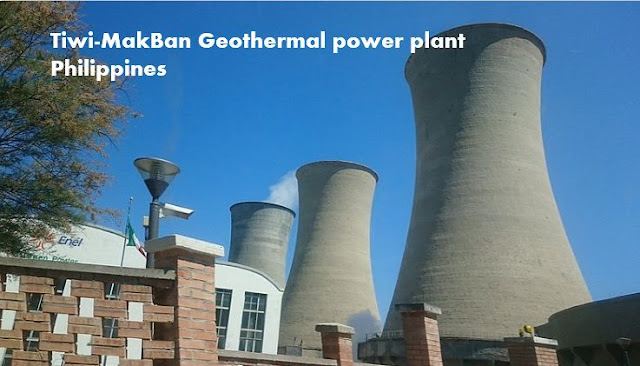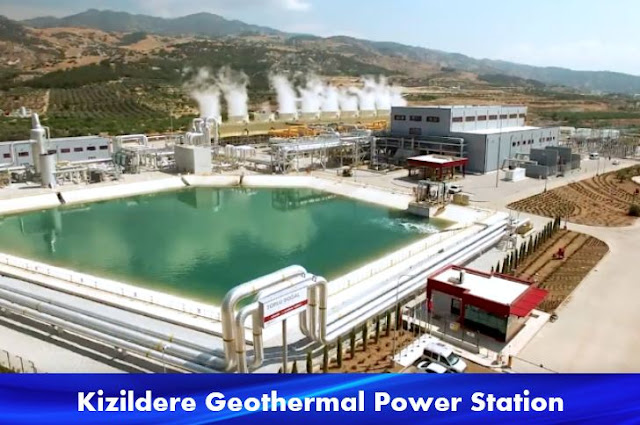Geothermal
Introduction Largest Geothermal Power Plants: What is Geothermal power plants
Geothermal power plants are facilities that generate electricity using heat from the Earth’s geothermal energy. The Earth’s internal heat is a natural source of energy that can be harnessed to generate electricity through a process called geothermal power generation.
As a renewable energy, Geothermal power plants use the natural heat from the Earth’s interior to produce steam, which drives a turbine that generates electricity. The process involves drilling a well into the Earth’s crust to access hot water and steam from underground reservoirs. The steam is then used to drive turbines that generate electricity, which is distributed to the power grid for use by consumers.
Geothermal power plants are a form of renewable energy, as they do not rely on fossil fuels and produce very little greenhouse gas emissions. They are also a relatively stable source of electricity, as the heat from the Earth’s interior is a constant and reliable source of energy.
While geothermal power generation is currently less common than other forms of renewable energy such as wind or solar power, it has the potential to play an important role in reducing greenhouse gas emissions and transitioning to a more sustainable energy system.
Benefit of Geothermal power plants
Geothermal power plants offer several benefits for renewable energy diversity.
One of the main advantages of geothermal power is that it provides a consistent and reliable source of electricity, unlike other forms of renewable energy such as wind and solar power which are intermittent and dependent on weather conditions.
This means that geothermal power plants can provide a stable source of energy to complement other forms of renewable energy, helping to balance out the variability of other renewable sources in the energy mix.
Another benefit of geothermal power plants is that they can be located close to the areas where the electricity is needed, reducing the need for long-distance transmission lines. This can help to improve energy efficiency and reduce transmission losses, which can result in lower electricity costs for consumers.
Geothermal power plants also have a relatively low environmental impact compared to other forms of electricity generation. They produce very little greenhouse gas emissions and require a relatively small amount of land area compared to other forms of renewable energy. Additionally, the technology used in geothermal power plants is well-established and proven, meaning that there are few technological or operational risks associated with this form of energy generation.
Gothermal power plants offer a reliable, low-impact, and complementary source of renewable energy that can help to diversify the energy mix and reduce greenhouse gas emissions.
20 largest Geothermal power plants in the world
Geothermal power plants are a form of renewable energy that harnesses heat from the Earth’s core to generate electricity. With the increasing demand for clean and sustainable energy, geothermal power plants have become a popular option for countries around the world. In this article, we will be providing a summary of the 20 largest geothermal power plants in the world and their location.
| Rank | Name of Power Plant | Country | Capacity (MW) | Commissioned |
|---|---|---|---|---|
| 1 | Cerro Prieto Geothermal Power Station | Mexico | 820 | 1973 |
| 2 | Geysers Geothermal Complex | United States | 720 | 1960-1989 |
| 3 | Larderello Geothermal Power Plant | Italy | 773 | 1913 |
| 4 | CalEnergy Generation – Salton Sea | United States | 346 | 1987 |
| 5 | Malitbog Geothermal Power Station | Philippines | 232.5 | 2006 |
| 6 | Hellisheiði Power Station | Iceland | 303 | 2010 |
| 7 | Wayang Windu Geothermal Power Station | Indonesia | 227 | 2000 |
| 8 | Nesjavellir Power Station | Iceland | 120 | 1990 |
| 9 | Kawerau Geothermal Power Station | New Zealand | 100 | 1958 |
| 10 | Kamojang Geothermal Power Station | Indonesia | 200 | 1982 |
| 11 | Darajat Geothermal Power Station | Indonesia | 255 | 1994 |
| 12 | Salak Geothermal Power Station | Indonesia | 377 | 1994 |
| 13 | Tiwi Geothermal Power Station | Philippines | 330 | 1997 |
| 14 | Makban Geothermal Power Station | Philippines | 458 | 1979 |
| 15 | Reykjanes Power Station | Iceland | 100 | 1977 |
| 16 | Olkaria Geothermal Power Station | Kenya | 280 | 1981 |
| 17 | Ngatamariki Power Station | New Zealand | 82 | 2013 |
| 18 | Ohaaki Power Station | New Zealand | 109 | 1989 |
| 19 | Wairakei Geothermal Power Station | New Zealand | 162 | 1958 |
| 20 | Kizildere Geothermal Power Plant | Turkey | 80 | 1984 |
Here is Some explanation for 20 Largest Geothermal Power Plant in The World
Largest Geothermal Power Plants: Cerro Prieto Geothermal power plant- Mexico
The Cerro Prieto Geothermal Power Station is a geothermal power plant located in the northern region of Baja California, Mexico. It is one of the oldest and largest geothermal power plants in the world.
In the 1950s, the Mexican government began exploring the possibility of using geothermal energy as a source of electricity. In 1958, the Mexican government signed an agreement with the United States government to conduct joint research on geothermal energy in the region.
In 1960, a team of geologists and engineers began drilling exploratory wells in the Cerro Prieto region. The first geothermal well was drilled in 1964, and by 1973, the first 50 megawatt turbine generator was installed and producing electricity.
Cerro Prieto Geothermal Power Station Located in Baja California, Mexico, the Cerro Prieto geothermal power plant has an installed capacity of 820 MW. It has been operating since 1973 and generates about 4% of Mexico’s electricity.
Largest Geothermal Power Plants: The Geysers Geothermal power plant- California, United States
The Geysers is the largest geothermal power plant in the world, located in California, United States. It has a total installed capacity of 1,517 MW and generates around 5% of California’s electricity.
Largest Geothermal Power Plants: Larderello Geothermal power plant- Italy
Larderello is the oldest geothermal power plant in the world, located in Tuscany, Italy. It has an installed capacity of 769 MW and has been in operation since 1913.
Largest Geothermal Power Plants: CalEnergy Generation Geothermal Power Plant – California
CalEnergy Generation is a geothermal power plant located near the Salton Sea in southern California. The Salton Sea is a large, shallow saltwater lake that was accidentally created in 1905 when an irrigation canal burst and flooded the Salton Sink.
The development of geothermal power at the Salton Sea began in the 1970s, when the US Department of Energy funded a research project to explore the potential for geothermal power generation in the region. CalEnergy Generation was established in 1984 as a subsidiary of Berkshire Hathaway Energy, and it began operating the first geothermal power plant at the Salton Sea in 1987.
The CalEnergy Generation geothermal power plant uses a process called binary cycle power generation to produce electricity. In this process, hot geothermal fluid is used to vaporize a low boiling-point fluid, which then drives a turbine to generate electricity. The cooled geothermal fluid is then injected back into the ground to maintain the geothermal resource.
Largest Geothermal Power Plants: Malitbog Geothermal power plant- Philippines
Malitbog Geothermal Power Plant is a geothermal power plant located in Barangay Tongonan, Kananga, Leyte, Philippines. It is operated by the Energy Development Corporation (EDC), the largest geothermal energy producer in the country. The power plant was commissioned in 1996 and has an installed capacity of 232.5 MW, making it one of the largest geothermal power plants in the Philippines.
The Malitbog Geothermal Power Plant uses steam produced by the natural heat of the earth to generate electricity. The plant has four units, each with a capacity of 58.125 MW. The steam is extracted from deep underground through production wells and is then used to drive turbines that generate electricity
The Malitbog geothermal power plant is located in Leyte, Philippines and has an installed capacity of 232 MW. It is operated by the Energy Development Corporation and supplies around 5% of the country’s electricity.
Largest Geothermal Power Plants: Hellisheidi Geothermal power plant- Iceland
Hellisheidi Geothermal Power Plant is a geothermal power station located in southwest Iceland, approximately 30 kilometers east of the capital city Reykjavik. It is the largest geothermal power station in the world, with a capacity of 303 megawatts of electricity and 133 megawatts of thermal energy.
The power plant uses a combination of geothermal wells and steam turbines to generate electricity. It is situated on a volcanic field that is rich in geothermal energy, which is harnessed by drilling wells into the ground to extract hot water and steam. The steam is then used to power the turbines, which generate electricity. The hot water is also used to heat homes and buildings in Reykjavik through a district heating system.
In addition to producing electricity and heating, the Hellisheidi Geothermal Power Plant is also used for research and development into geothermal energy. It is operated by the Icelandic utility company Reykjavik Energy, which is responsible for providing electricity and heating to the Reykjavik area.
Hellisheidi is Iceland’s largest geothermal power plant with an installed capacity of 303 MW. It is located near the country’s capital, Reykjavik and supplies around 8% of the country’s electricity.
Largest Geothermal Power Plants: Wayang Windu Geothermal power plant- Indonesia
The power plant has a total installed capacity of 227 MW and utilizes the geothermal energy from the Wayang Windu geothermal field, which is located in the Bandung Regency. The field has an estimated potential of 600 MW of geothermal energy.
The Wayang Windu geothermal power plant consists of two power stations, the Wayang Windu I and II. Wayang Windu I has an installed capacity of 110 MW and started operation in 1999, while Wayang Windu II has an installed capacity of 117 MW and started operation in 2009.
Located in West Java, Indonesia, Wayang Windu is the country’s largest geothermal power plant with an installed capacity of 227 MW. It is operated by PT Pertamina Geothermal Energy and provides electricity to the Java-Bali grid.
Largest Geothermal Power Plants: Nesjavellir Geothermal power plant- Iceland
Nesjavellir Geothermal power plant is Iceland’s third-largest geothermal power plant with an installed capacity of 120 MW. It is located near the country’s capital, Reykjavik and supplies around 2% of the country’s electricity.
Nesjavellir Geothermal Power Plant is a geothermal power station located in Iceland, about 30 kilometers east of Reykjavik. It is one of the largest geothermal power plants in Iceland and generates approximately 120 MW of electricity and 1,100 liters of hot water per second.
The power plant utilizes the high-temperature geothermal reservoirs of the Hengill volcanic system, which is located beneath the Nesjavellir area. The reservoirs consist of superheated water and steam that are extracted from wells drilled into the ground. The steam is then used to power turbines, which generate electricity, while the hot water is used for heating and other purposes.
One of the unique features of the Nesjavellir Geothermal Power Plant is that it is not only used for generating electricity, but also for supplying hot water to the nearby capital city of Reykjavik. The hot water is transported through a network of pipelines to homes and buildings in the city, providing heating and hot water for the residents.
Largest Geothermal Power Plants: Kawerau Geothermal power plant- New Zealand
Kawerau is New Zealand’s second-largest geothermal power plant with an installed capacity of 100 MW. It is located in the Bay of Plenty region and is operated by Norske Skog Tasman.
The Kawerau Geothermal power plant is located in Kawerau, New Zealand, and is a geothermal power plant that generates electricity using the natural heat of the Earth. The plant is owned and operated by Contact Energy, one of New Zealand’s largest electricity generators and retailers.
The Kawerau Geothermal power plant began operations in 1958 and has been expanded and upgraded several times since then. It currently has a capacity of 100 megawatts (MW) and is capable of supplying electricity to around 100,000 homes.
The power plant draws its energy from a geothermal field located beneath the Kawerau township. The geothermal field contains a high temperature and high-pressure reservoir of hot water and steam that is used to drive turbines and generate electricity. The geothermal energy is a renewable source of energy and produces no greenhouse gas emissions.
Largest Geothermal Power Plants: Kamojang Geothermal Power Station
The Kamojang Geothermal Power Station is a geothermal power plant located in the Garut Regency, West Java, Indonesia. It was the first geothermal power plant to be built in Indonesia and one of the first in the world.
The power station was built in 1982 and has a total installed capacity of 235 MW. It utilizes geothermal fluid from the nearby Kamojang geothermal field to generate electricity using a binary cycle power plant. The plant consists of ten units, each with a capacity of 10-60 MW.
The Kamojang Geothermal Power Station is one of several geothermal power plants in Indonesia, which has some of the largest geothermal resources in the world. Geothermal energy is a significant contributor to Indonesia’s electricity generation capacity, accounting for approximately 5% of the country’s total electricity generation.
In addition to its economic benefits, the Kamojang Geothermal Power Station has also been recognized for its environmental benefits. Geothermal energy is a renewable energy source that does not emit greenhouse gases or other harmful pollutants associated with traditional fossil fuel power generation. The use of geothermal energy has helped Indonesia to reduce its dependence on fossil fuels and meet its greenhouse gas emissions reduction targets.
Largest Geothermal Power Plants: Darajat Geothermal Power Station
The Darajat Geothermal Power Station is a geothermal power plant located in the Garut Regency, West Java, Indonesia. It is owned and operated by PT Pertamina Geothermal Energy, a subsidiary of the Indonesian state-owned oil and gas company, Pertamina.
The power station was built in 1994 and has a total installed capacity of 270 MW. It utilizes geothermal fluid from the nearby Darajat geothermal field to generate electricity using a binary cycle power plant. The plant consists of nine units, each with a capacity of 30 MW.
The Darajat Geothermal Power Station is one of several geothermal power plants in Indonesia, which has some of the largest geothermal resources in the world. Geothermal energy is a significant contributor to Indonesia’s electricity generation capacity, accounting for approximately 5% of the country’s total electricity generation.
Largest Geothermal Power Plants: Salak Geothermal power plant- Indonesia
Located in West Java, Indonesia, the Salak geothermal power plant has an installed capacity of 377 MW. It is operated by PT Pertamina Geothermal Energy and provides electricity to the Java-Bali grid.
The Salak Geothermal Power Plant is a geothermal power plant located in West Java, Indonesia. It is owned and operated by PT Pertamina Geothermal Energy, a subsidiary of the state-owned oil and gas company, Pertamina.
The Salak Geothermal Power Plant was built in the 1990s, and it began commercial operation in 1994. The plant has a total installed capacity of 377 MW, making it one of the largest geothermal power plants in the world.
The Salak geothermal field is located in the area surrounding Mount Salak, and it is one of the largest geothermal fields in Indonesia, with estimated reserves of over 1 GW. The field is characterized by high temperatures and pressures, and it contains both liquid and vapor-dominated reservoirs.
The Salak Geothermal Power Plant is an important contributor to Indonesia’s energy mix, providing a significant amount of electricity to the Java-Bali power grid. In addition to its commercial operation, the plant is also involved in research and development activities related to geothermal energy, including exploration, drilling, and reservoir management.
Largest Geothermal Power Plants: Tiwi-MakBan Geothermal power plant- Philippines
The Tiwi-MakBan geothermal power plant is located in the Philippines and has a total installed capacity of 691 MW. It is operated by the Energy Development Corporation and generates around 16% of the country’s electricity.
The Tiwi-MakBan geothermal power plant is located in the Philippines and is one of the largest geothermal power plants in the world. The plant is operated by the Energy Development Corporation (EDC) and generates electricity from the natural steam produced by the geothermal reservoirs in the area.
The Tiwi-MakBan geothermal power plant consists of two separate facilities: the Tiwi geothermal power plant located in the town of Tiwi in the province of Albay, and the MakBan geothermal power plant located in the town of Bay in the province of Laguna. The Tiwi plant has a capacity of 330 megawatts (MW), while the MakBan plant has a capacity of 1,100 MW, making the total capacity of the Tiwi-MakBan complex 1,430 MW.
The Tiwi-MakBan geothermal power plant was first developed in the 1970s by the Philippine National Oil Company (PNOC), and was later privatized in 2007 when EDC acquired the facilities. The plant plays a significant role in the energy mix of the Philippines, as it provides clean and renewable energy to the Luzon grid, which serves the country’s most populated island.
Largest Geothermal Power Plants: Reykjanes Geothermal power plant- Iceland
Reykjanes is Iceland’s second-largest geothermal power plant with an installed capacity of 100 MW. It is located on the Reykjanes Peninsula and supplies around 3% of the country’s electricity.
Reykjanes Geothermal Power Plant is a geothermal power plant located on the Reykjanes Peninsula in southwestern Iceland. It is owned and operated by the national power company, Landsvirkjun, and is one of the largest geothermal power plants in Iceland.
The plant began operation in 2006 and has a total capacity of 100 MW, which is generated by five individual units. The plant uses the energy from the high-temperature geothermal reservoirs found beneath the surface of the Reykjanes Peninsula to generate electricity.
In addition to producing electricity, the Reykjanes Geothermal Power Plant also provides hot water for space heating in the nearby towns of Reykjavik and Keflavik. The plant also has a visitor center where visitors can learn about geothermal energy and the technology used to harness it.
Largest Geothermal Power Plants: Olkaria Geothermal Power Station
Olkaria Geothermal Power Station is a geothermal power plant located in the Rift Valley Province of Kenya, Africa. It is one of the largest geothermal power stations in Africa and the world, with a total installed capacity of 720 MW as of my knowledge cutoff in September 2021.
The Olkaria Geothermal Power Station is located in the Olkaria geothermal field, which is situated within Hell’s Gate National Park. The power station is operated by the Kenya Electricity Generating Company (KenGen), which is the leading electric power generation company in Kenya.
The Olkaria Geothermal Power Station consists of several plants, including Olkaria I, II, III, and IV. Olkaria I has an installed capacity of 45 MW, Olkaria II has an installed capacity of 105 MW, Olkaria III has an installed capacity of 140 MW, and Olkaria IV has an installed capacity of 280 MW.
The power station is a significant contributor to Kenya’s electricity generation capacity, accounting for over 50% of the country’s total installed capacity. The Olkaria Geothermal Power Station has helped to reduce the country’s dependence on fossil fuels and has played a critical role in supporting economic growth and development in Kenya.
Largest Geothermal Power Plants: Ngatamariki Geothermal power plant- New Zealand
Ngatamariki is located in the North Island of New Zealand and has an installed capacity of 82 MW. It is operated by Contact Energy and supplies around 2% of the country’s electricity.
The Ngatamariki Geothermal Power Plant is a geothermal power station located in the Taupo Volcanic Zone of New Zealand. It is situated approximately 17 kilometers northeast of Taupo, near the town of Reporoa. The power plant is owned and operated by Contact Energy, one of New Zealand’s largest energy companies.
The Ngatamariki power plant uses a binary cycle process to generate electricity. Hot water from the geothermal reservoir is pumped to the surface and passed through a heat exchanger. The heat exchanger transfers the heat from the geothermal fluid to a secondary working fluid with a lower boiling point, such as isobutane or pentane. The working fluid vaporizes, drives a turbine, and generates electricity. After passing through the turbine, the vapor is cooled and condensed back into a liquid form and returned to the heat exchanger to repeat the cycle.
Largest Geothermal Power Plants: Ohaaki Geothermal power plant- New Zealand
Ohaaki is New Zealand’s third-largest geothermal power plant with an installed capacity of 84 MW. It is located in the North Island and is operated by Contact Energy.
The Ohaaki Geothermal Power Station is a geothermal power plant located in New Zealand, on the North Island near the town of Wairakei. The plant is owned and operated by Contact Energy, which is New Zealand’s largest electricity generator and retailer.
The power station was first commissioned in 1989 and has a total installed capacity of 104 MW, making it one of the largest geothermal power plants in New Zealand. The plant uses a combination of binary and flash steam technologies to generate electricity from the natural geothermal resources found in the area.
The Ohaaki power station draws steam from a geothermal field known as the Ngatamariki field, which is located about 15 km from the power plant. The steam is brought to the surface through production wells and is separated into steam and water in a series of separators. The steam is then used to drive turbines, which in turn generate electricity, while the separated water is re-injected back into the geothermal reservoir.
Largest Geothermal Power Plants: Wairakei Geothermal Power Station, New Zealand
The Wairakei Geothermal Power Station is a geothermal power plant located in the town of Taupo, in the North Island of New Zealand. It was the first geothermal power station to be built in New Zealand and one of the first in the world.
The power station was built in 1958 and has a total installed capacity of 162 MW. It utilizes geothermal fluid from the nearby Wairakei geothermal field to generate electricity using a binary cycle power plant. The plant consists of six units, each with a capacity of 22-29 MW.
The Wairakei Geothermal Power Station was originally built to provide electricity to the town of Taupo and its surrounding areas. However, it quickly became a major contributor to New Zealand’s electricity generation capacity and remains an important source of renewable energy in the country today.
Largest Geothermal Power Plants: Kizildere Geothermal Power Plant
Kizildere Geothermal Power Plant is a geothermal power plant located in the Kizildere geothermal field, which is situated in the Denizli Province of Turkey. It is one of the largest geothermal power plants in Turkey and the world, with a total installed capacity of 185 MW as of my knowledge cutoff in September 2021.
The power plant is operated by Zorlu Energy, which is a subsidiary of the Zorlu Group, a Turkish conglomerate that operates in various sectors including energy, textiles, and electronics. The Kizildere Geothermal Power Plant began operation in 2013 and consists of four units, each with a capacity of 45-50 MW.
The Kizildere geothermal field is estimated to have a potential capacity of 1,000 MW, making it one of the largest geothermal resources in Turkey. The field has been used for geothermal energy production since the 1970s, and the Kizildere Geothermal Power Plant is the largest facility to be built in the area to date.
The utilization of Largest Geothermal Power Plants
The utilization of geothermal energy has been increasing around the world in recent years. Geothermal energy is a renewable energy source that is produced by harnessing the Earth’s internal heat. It is a clean and sustainable energy source that does not produce greenhouse gas emissions or other pollutants associated with fossil fuel combustion.
Many countries have invested in geothermal energy as a way to diversify their energy mix and reduce their dependence on fossil fuels. According to the International Geothermal Association, as of 2020, there were approximately 14,900 MW of installed geothermal capacity worldwide, with an additional 3,600 MW under development.
The largest producers of geothermal energy are the United States, Indonesia, and the Philippines. In the United States, the Geysers Geothermal Complex in California is the largest geothermal power plant in the world with a capacity of 720 MW. In Indonesia, the country’s geothermal potential is estimated at over 29,000 MW, and the government has set a target of achieving 7,200 MW of installed geothermal capacity by 2025. The Philippines has over 1,900 MW of installed geothermal capacity, making it the second-largest producer of geothermal energy in the world.
Other countries that are investing in geothermal energy include Kenya, Iceland, Turkey, New Zealand, Italy, and Mexico. These countries are all working to expand their geothermal capacity and develop new technologies to improve the efficiency and cost-effectiveness of geothermal power generation.
The increasing utilization of geothermal energy around the world is a positive development for renewable energy and the fight against climate change. With its clean and sustainable characteristics, geothermal energy has the potential to play a significant role in the transition to a more sustainable and low-carbon energy system.
Conclusion of 20 largest Geothermal power plants in the world
Geothermal power plants are an important source of renewable energy and are being used by countries around the world to reduce their reliance on fossil fuels.
The 20 largest geothermal power plants in the world provide a significant amount of electricity to their respective countries and demonstrate the potential of this clean energy source.
Geothermal energy has the potential to provide a reliable and sustainable source of electricity. Unlike solar and wind power, which are dependent on weather conditions, geothermal power plants can operate 24/7, providing a constant source of energy. Additionally, geothermal energy is a clean source of energy, producing little to no greenhouse gas emissions or other pollutants.
As the world continues to transition towards renewable energy, geothermal power is likely to play an increasingly important role. However, the development of geothermal power plants can be expensive, and they require a specific set of geological conditions to be viable. Nonetheless, as technology advances and more countries invest in renewable energy, the potential for geothermal power is likely to grow.
It is worth noting that geothermal power plants can also have significant impacts on local ecosystems and communities. The construction of the plants can disrupt natural habitats and cause displacement of indigenous populations. Additionally, the extraction of geothermal fluids can have an impact on local water resources.
The 20 largest geothermal power plants in the world demonstrate the potential of geothermal energy as a reliable and sustainable source of electricity. However, careful consideration must be given to the environmental and social impacts of these plants, and efforts should be made to minimize these impacts while maximizing the benefits of this renewable energy source.
https://www.exaputra.com/2023/04/the-20-largest-geothermal-power-plants.html
Renewable Energy
How Should the Measles/Mumps/Rubella Vaccine Be Administered? Should You Ask a High School Baseball Coach?
 There are so many things going wrong in this country simultaneously that it’s hard to list them all.
There are so many things going wrong in this country simultaneously that it’s hard to list them all.
Here’s something that no one could have seen coming: (see short video here) crackpot politicians giving parents insane medical advice about how to care for their children.
If I told you that our country’s parents were making decisions on vaccinating their children based on information provided by figure skaters or lawn mower salesmen, you wouldn’t believe me.
But the case is actually worse; it’s coming from the White House.
Renewable Energy
Do Americans Approve of Our Country’s Execution of Innocent People?
 In this short video on the bombing of ships leaving Venezuela, President Trump asserts that drug overdoses took like lives of more than 350,000 people last year, a figure that, according to the CDC, is actually 79,383.
In this short video on the bombing of ships leaving Venezuela, President Trump asserts that drug overdoses took like lives of more than 350,000 people last year, a figure that, according to the CDC, is actually 79,383.
In any case, the video fails to mention that executing people who have not been charged with and convicted of a crime is a violation of both domestic and international law.
Do Americans Approve of Our Country’s Execution of Innocent People?
Renewable Energy
Why January 6th Wasn’t the End of Trump/MAGA
 Keep in mind that, in 2020, more than 70 million voters cast their ballots for Trump, who, though he is a pathological liar, is 100% trusted by his supporters. When Trump said the election was rigged, the vast majority of these folks believed him. Even today, more than five years later, there are still millions of people who believe there was rampant voter fraud in the election.
Keep in mind that, in 2020, more than 70 million voters cast their ballots for Trump, who, though he is a pathological liar, is 100% trusted by his supporters. When Trump said the election was rigged, the vast majority of these folks believed him. Even today, more than five years later, there are still millions of people who believe there was rampant voter fraud in the election.
Now, is storming the Capitol and beating up/killing law enforcement personnel an acceptable solution? It wouldn’t be for you or me, or most people, but imagine you’re an uneducated white-supremacist MAGA guy, and your president is telling you to do whatever’s necessary to prevent the election from being certified.
These are people who were so desperate to hang Mike Pence that the vice president had to be escorted out of the Capitol building to a secret and secure location, so he didn’t end up at the end of a rope.
When asked about this, Trump replied, “Maybe he deserved it.” To anyone trying to make sense of this, remember that you’re dealing with a deeply disturbed individual, and many millions of truly pathetic people who believe his is an honest and effective servant of the American people. In congress, we have a couple of hundred of the most terrible butt-kissers imaginable, all clamoring to curry favor with him.
-
Climate Change2 years ago
Spanish-language misinformation on renewable energy spreads online, report shows
-
Climate Change3 months ago
Guest post: Why China is still building new coal – and when it might stop
-
Climate Change Videos2 years ago
The toxic gas flares fuelling Nigeria’s climate change – BBC News
-

 Greenhouse Gases1 year ago
Greenhouse Gases1 year ago嘉宾来稿:满足中国增长的用电需求 光伏加储能“比新建煤电更实惠”
-
Greenhouse Gases3 months ago
Guest post: Why China is still building new coal – and when it might stop
-

 Climate Change1 year ago
Climate Change1 year ago嘉宾来稿:满足中国增长的用电需求 光伏加储能“比新建煤电更实惠”
-

 Carbon Footprint2 years ago
Carbon Footprint2 years agoUS SEC’s Climate Disclosure Rules Spur Renewed Interest in Carbon Credits
-
Renewable Energy4 months ago
US Grid Strain, Possible Allete Sale



